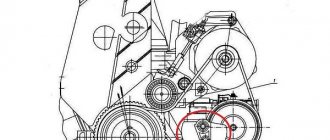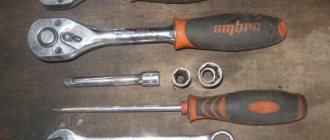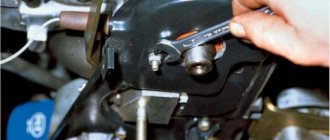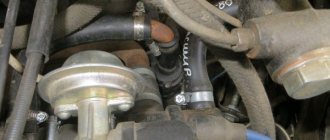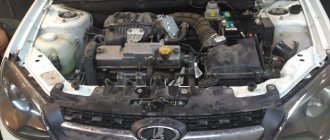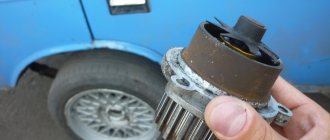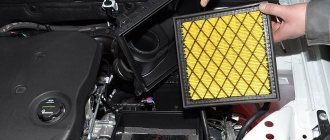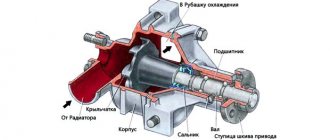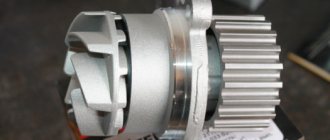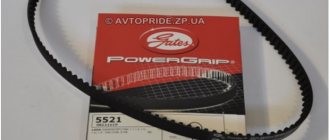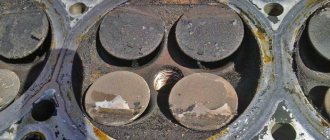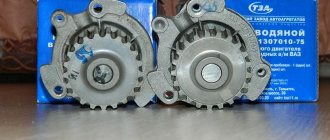How to determine if the pump is faulty on Kalina
Despite its simple design, the pump may fail sooner or later. The first signal of incorrect operation of the water pump is extraneous noise that occurs when the engine is running. On the Lada-Kalina, the service life of the device is 60 thousand kilometers or after 48 months of operation. When one of these indicators is reached, it is recommended to replace the part without waiting for signs of malfunction to appear.
A fairly common reason for pump failure is the appearance of extraneous noise, which is associated with bearing wear.
But there are situations when a pump breakdown occurs much earlier than the specified period. Assessing the performance of a node is quite simple. To do this you need:
- Start and warm up the engine to operating temperature.
- Put a glove on your hand and squeeze the upper radiator pipe. When the pump is working, pressure will immediately be felt, which is due to the circulation of liquid through the system.
- If there appears to be little or no pressure, the pump should be inspected in more detail.
To assess the external condition of the pump, you will need to dismantle the timing drive casing and make sure it is in good condition. In this case, you should keep in mind the following nuances:
- If a coolant leak is observed at the junction of the device housing and the engine, it means that the oil seal has failed.
- The appearance of noise from under the hood when the engine is running indicates high bearing wear.
- There should be no axial movement when rocking the drive gear. If there is play, then normal operation of the pump is impossible.
A fairly common failure is the appearance of a coolant leak due to a damaged oil seal.
In these simple ways, the performance of the pump is determined. Even if you have no experience in car repair, you can find a faulty part. If it has been discovered that the pump has some problems, then there is no need to delay repairs, since simple malfunctions can lead to a major overhaul of the motor.
How to lubricate the pump on Kalina
If we talk about servicing a water pump, then we are talking about lubricating the bearings of the device. The design uses two bearings located on the shaft. They don't require much lubrication to function properly, but they are necessary. When working “dry”, the wear of the part increases sharply. With some experience, the pump can be lubricated without removing it from the car. All you need to do is follow these steps:
- Remove the timing cover.
- Remove dirt from the pump and its seating area.
- Apply a little Litol-24 lubricant to the housing joints.
Depending on the installed water pump, the product may have a lubrication hole.
High-quality lubrication can be performed during repair work, when parts that have failed are replaced. But if you lubricate the part in the manner described, you can also provide the bearings with the necessary amount of lubricant.
Article on the topic: AT or AMT gearbox: which is better to choose
Determining the performance of a part
In some ways, the water pump is a pretty tricky part. Without disassembling the timing belt assembly, it is not so easy to determine its performance.
But there are some signs of a pump malfunction that require you to pay close attention to it:
- At an early stage of wear, bearing noise appears. Not every auto mechanic, let alone an ordinary car enthusiast, will be able to distinguish it. But if you managed to catch this noise, then there is a reason to look under the plastic cover of the gas distribution mechanism.
- Wet marks under the timing cover and a belt shiny with moisture indicate that antifreeze is gradually penetrating into the compartment. Naturally, through the pump.
- The belt is not in the center of the camshaft gear, but is shifted to the very edge. This happens when, due to play in the pump bearing, the gear warps and the belt slides to the side.
- The coolant in the expansion tank of the Lada Kalina gradually decreases, and wet spots are constantly observed under the car directly under the timing mechanism.
Preparatory activities
Before changing the pump on Kalina, you will have to partially empty the cooling system. Antifreeze should only be drained from the cylinder block; there is no need to touch the radiator. Unless you notice fluid leaking on the pipes, then you can change the hoses at the same time. The procedure is performed according to the following algorithm:
- Remove the mudguard that protects the engine from below from dirt. It is held on by bolts with 10 mm socket heads.
- Disconnect the positive terminal from the battery and the high-voltage wires from the ignition coil. Unscrew the coil mount with a 5 mm hexagon and move it to the side, freeing access to the drain plug.
- Empty the cylinder block by placing a special container and unscrewing the drain plug with a 13 mm wrench. In this case, it is necessary to open the cap of the expansion tank.
- If you need to empty the radiator, you should move the container under its drain neck and also unscrew the plug.
Symptoms of a problem
A breakdown can be determined by several signs. They can appear both together and separately. Or it may not appear at all until the pump completely fails. Signs of failure are as follows:
- The temperature of the coolant increases;
- Bearing whistling;
- Knock from the pump;
- Fluid leaks on the pump or belt.
Sometimes a bearing may jam immediately. Then you can be congratulated on your large-scale repair of the gas distribution mechanism. A knocking sound when a bearing wears out is often confused with camshaft knocking, so diagnosing this symptom should be taken more carefully. Necessary tool
. To carry out repair work, you will need a set of keys, a mounting blade and special tools for unscrewing the camshaft and crankshaft. And also a device for adjusting the timing belt tension. It would be nice if you have an assistant available. Some actions are difficult to do alone.
Engine Cooling Water Pump
Here it is, a mine - a water pump. Refers to the cooling system, but is driven by a timing belt. If the pump wedges due to the death of the bearing, it will cut off the teeth on the belt, and then there will be destruction in the motor. And they “forgot” to mention this detail in the routine maintenance section of all service books. What to do with it? The consumer can only guess. Should we wait for death from natural wear and tear on a plug-in motor? Stupidity. And if changed, then when? It seems that the mine is not even the water pump itself, but the complete disregard for it in all the official VAZ “literature” for the consumer.
New VAZ engines are now equipped with high-quality timing belts from well-known brands. I believe that if no oil gets on it, it will cost 180 thousand. But is the difference in components really so great that on the 8-valve VAZ-11186 for Granta the belt must be changed at the 75th thousand, and on its closest relative VAZ-11189 at the 180th?
Let's continue the research. The pulleys are not demolished at all. Pressure roller bearing up to 180 thousand? Let's admit it, although it's hard to believe. But why change all this equipment at the 180th thousand, if the estimated life of the engine is 220 thousand km? Refresh before demise or major overhaul? If you don’t believe me, look at the photo taken in the workshops where VAZ engines are produced.
Engine valves VAZ-21116
The average consumer has access to only those that come with the car from official documents. What follows from them? Open the Grants service book. Replacing the timing belt - at 75 thousand kilometers for an 8-valve engine, not a word about the 16-valve belt! The same situation is with Kalina - I came across a book where there is nothing to say about one engine, but on the other we only check the condition of the belt, but there is no talk of a planned replacement. It’s even more fun with the Priora - there are service books where there is not a word at all about the gas distribution mechanism, but the air conditioning compressor belt is mentioned in almost every maintenance coupon.
With Vesta and Xray, progress is obvious - at 45, 75, 105, 135 and 165 thousand we adjust the gaps in the gas distribution mechanism. And for the first time we plan to remember the timing belt along with the rollers for 180 thousand kilometers! This is for 16-valve engines VAZ-21129, 21179 and 8-valve Vesta VAZ-11189. I can’t do without the quote: “2.11. Replace the timing belt along with the rollers. 2.12. Replace the crankshaft and camshaft sprockets. Replace the toothed belt, tensioner and support roller (for the VAZ-11189 8-cl. engine, only the tensioner) of the engine gas distribution mechanism drive. Adjust the tension of the toothed belt." Not only is the oil oil (we change the same belt twice), but of all the parts, they didn’t remember the most vulnerable one - the pump!
Symptoms of damaged water pump
- Motor overheating - the pump
is faulty, the drive belt is not working, the impeller is damaged. - The temperature arrow indicator is located closer to the middle. It is necessary to brake to check the radiator. For which the inoperability design is intended, the unit and the pump drive will heat up.
- Noisy, smell of antifreeze in the cabin.
- Low antifreeze circulation is the result of pump destruction. Diagnosis is carried out with the engine idling; you must immediately clamp and lower the outer radiator hose. During normal operation of the pump, a push of antifreeze in the hose will be felt.
- Large free play of the ball bearing of the pump - damage to the ball bearings.
It is necessary to change the water pump if the car's mileage is 90 thousand km.
Fault diagnosis
If the first suspicions are confirmed, it’s time to make, so to speak, an expert opinion confirming the need to repair the VAZ 2110 pump, for which you should carry out several simple steps described below.
Checking the timing belt
First, let's check the pressure of the cooling system when the engine is warmed up to operating temperature. Let's try to press the rubber hose with our fingers. If the fluid pressure does not provide us with noticeable resistance, the pump is faulty.
Check the timing belt tension using the appropriate inspection window. Repair of the VAZ 2110 pump will indicate a worn or bitten belt, weakened by its tension, or it will be completely soaked in antifreeze.
In any case, after 20-30 thousand km. mileage, you should carefully listen to the characteristic humming or knocking sounds of a stuck pump system bearing. After 50 thousand, it is worth thinking about the mandatory need to replace the timing belt, pump and tension pulley.
How to determine the need to replace your pump
Replacing the Priora water pump. Warning! Do not turn the crankshaft or camshaft after the camshaft drive belt has been removed, otherwise the piston may hit the valves. Wear of the pump bearing (indicated by increased noise during operation) and leakage of coolant from the pump are the main defects of the water pump.
Description
| STEP # | |
| 1 | You need to disconnect the wire from the negative terminal of the battery. |
| 2 | Next, you should drain the coolant. |
| 3 | Then the piston of the first cylinder is set to the top dead center position. |
| 4 | Then the tension roller is removed. |
| 5 | The camshaft toothed pulley is removed behind the tension roller. |
| 6 | It is necessary to unscrew the 4 bolts and the fastening nut and start removing the rear cover of the camshaft drive belt. |
| 7 | Insert a screwdriver into the groove, carefully separate the pump from the block and remove it. |
| 8 | Then you need to remove the gasket from the pump. If it is damaged, it needs to be replaced. |
| 9 | Then, if the coolant leaks through the drain hole, then you need to replace the water pump (if the seal is damaged). |
| 10 | If the pump shaft exhibits noticeable axial play (or the bearing is damaged), replacement is also required. |
| 11 | If chips, cracks, or chipping are found on the toothed pulley, impeller and pump housing, it is also replaced. |
| 12 | You need to check the tightness of the pump bearing locking screw. The screw must be tightened if necessary. |
| 13 | Next, you need to install the pump in the reverse order of removal. In this case, the number on the part must be directed upward. |
| 14 | And finally, you need to install the remaining parts in the reverse order of removal. |
Water pump Luzar
In this case, the camshaft pulley must be installed with the protruding part of the hub facing the engine. Then you need to check the alignment of the top dead center marks on the rear drive belt cover and the camshaft pulley. The last step is to adjust the tension of the camshaft drive belt, and only after that add coolant.
A water pump can fail for two main reasons - wear of the bearing or oil seal. When the bearing wears out, a distinct hum will be heard, which is a sign that the bearing is humming and the pump needs to be replaced. If a pump with a faulty bearing is not replaced in time, this can lead to it jamming.
The second reason for pump malfunction is leakage from under the seal. If you notice that your antifreeze or antifreeze has begun to run out, one of the reasons is precisely the pump. Check for fluid leaks in the area where the pump is located.
If so, the pump is most likely leaking. In this case, operating the car is not advisable, but is possible provided that you have to constantly add coolant.
Another sign of a pump malfunction is a worn timing belt. If the bearing is broken, the pump may “walk” slightly, which will cause the belt to eat up, and as a result, the timing belt may break and then you will have to deal with the capital of the motor, since the valves will bend.
When choosing a pump, be sure to purchase one that is suitable for your motor. A pump for a 16 valve engine is not suitable for an 8 valve engine. The difference in replacing the water pump is that on an 8 valve engine there is 1 pulley, and on a 16 valve engine there are 2 pulleys. . By the way, from this article you can learn how to replace the fuel pump on a Lada Priora.
After draining the liquid, remove the upper decorative cover, the alternator belt, and then the front timing cover, it consists of two parts.
Now you need to set the timing marks so that during assembly you do not make a mistake with the ignition setting.
If you have a car with air conditioning, you need to use a 13 mm socket wrench to unscrew the bracket for the generator belt tensioner pulley and air conditioner with steering wheel.
The next step is to remove the crankshaft pulley. To do this, remove the right front wheel and mudguards. Next, engage 5th gear again and press the brake. The pulley will be fixed and can be safely unscrewed. Remove the pulley and timing belt.
Next, unscrew the 6 bolts securing the cover and then carefully remove it from the engine.
We unscrew the 6 bolts securing the pump, carefully pry it up with a screwdriver and pull it out. When installing a new pump, it is necessary to coat the gasket with a thin layer of sealant and screw the pump into place. Next, we reassemble in the reverse order, taking into account the timing marks.
Timing belt
How would you act on your own without clear instructions in the service book? On both an 8-valve and a 16-valve engine, I would change at least the pump, and better yet, the belt and tensioner between the 60th and 70th thousand kilometers. According to the period, if the mileage is small, for the sixth year of operation.
The water pump (water pump) of the engine cooling system is an important component that ensures constant circulation of coolant through the channels of the cooling jacket, pipes, lines, cooling radiator, etc. Even a slight decrease in the performance of a car pump can cause the engine to overheat, especially in the warm season.
Another reason to check whether the pump is working or not is possible extraneous noise in the water pump drive. In this case, the specified pump requires increased attention on some car models. The fact is that the pump can be driven by the timing belt. If the water pump jams, then the timing belt breaks, resulting in valve bending on most engines. Next, we will look at the available methods that allow you to check the water pump yourself.
Read in this article
Features of replacing the timing belt on Lada Kalina 2 (8 valves)
Be sure to check the tension of the kit at the end of the replacement procedure. The engine must be cool. For the battery, take a crocodile, and attach the belt to a pulley. The nuts are loosened using a wrench. The plate is fixed on a roller, the force is adjusted using a dynamometer. Make sure that the inner nut of the stud is in contact with the plate. Screw an additional nut at the top.
At the end you need to secure the roller, remove the plate and pin. Check the tension and adjust if necessary. More precise maintenance recommendations can be found in the technical manual for a specific car model.
It is necessary to check the tension, it is better to do it several times than to forget at all
Snapshot3
...by aligning mark 1 on the crankshaft toothed pulley with rib 2 of the oil pump cover.
...by aligning mark 1 on the crankshaft toothed pulley with rib 2 of the oil pump cover.
If necessary, repeat adjusting the valve timing and tensioning the timing belt. We perform assembly in reverse order. Tighten the generator drive pulley mounting bolt to a torque of 105–110 Nm.
[14 Lada Granta maintenance operations that will help you save]
[How to save money on scheduled maintenance of Lada Granta] [Maintenance of Lada Granta at 2.5 thousand km] [Maintenance of Lada Granta at 15,000 and 105,000 km] [Maintenance of Lada Granta at 30,000 and 60,000 km ] [Maintenance of Lada Granta at 45 thousand km] [Maintenance of Lada Granta at 75 thousand km] [Maintenance of Lada Granta at 90 thousand km] [Carrying out maintenance yourself - general recommendations] [Safety rules for doing it yourself carrying out maintenance] [Tools required for maintenance of Lada Granta] [Lamps used in the Lada Granta car]
Device feature, failure symptoms
This is what the pump for Kalina looks like
The pump works in conjunction with the engine. It ensures uninterrupted operation of the fuel supply and cooling systems. The first one transfers fuel from the tank to the engine. The next reason is the forced pumping of antifreeze, or antifreeze.
The water pump-impeller, located on the shaft, is covered by a housing. The shaft has ball bearings at both ends and rotates due to a rotating moment by means of a belt attached to the engine.
Symptoms of a water pump failure:
- the reddish section of the tachometer indicates the overheating temperature of the car’s engine, this is confirmed by the readings of the device;
- in the cabin of the Kalina car there is a persistent smell from the evaporation of antifreeze;
- a sound similar to a whistle can be heard quite clearly - repair or replacement of the pump is needed;
- there is an option to find drops of water under the car (to identify the problem, leave a sheet of snow-white paper under the car while you sleep).
Restoring the pump to function requires experience and special tools. It is better to entrust the work to 100% specialists, and at the same time replace the pump with the newest one.
Installation instructions for an additional electric pump
Installing an additional water pump on any car (including the Lada Priora has 16 valves) is, in principle, no different. It is necessary to place the electric pump in the section of the pipe, which is the input or output to the car’s stove and provide its power supply.
Step-by-step instructions for installing this additional component are as follows:
- Provide access to the heater pipes under the hood of the car by removing components that interfere with operation.
- Compress one of the rubber pipes that comes out of the heater (stove), which is done to prevent coolant from leaking out, or drain antifreeze (antifreeze) from the entire system.
- Cut part of this pipe to the length of the corresponding pump being installed.
- The length of the fittings is not taken into account due to the fact that they fit into the pipes.
- It is necessary to select the diameter of the fittings on the electric pump in advance to obtain a high-quality connection.
- Secure the rubber pipes to the pump fittings using metal clamps.
- Attach the additional electric pump to a pre-selected location under the hood of the car (indicated above) using special fasteners.
- Connect the power supply to the pump by selecting the options listed above, or install a separate switch.
- Start the engine and check the tightness of the connections, as well as the functionality of the electric pump.
- Install all parts that were removed before installing the pump.
Purpose of the pump
In general, Lada Granta cars have the status of reliable, and most importantly, easy to use and maintain cars. In addition, the main advantage inherent in this brand is the fact that the motorist can replace any part with his own hands. And if you need to repair the pump, you can easily change it yourself.
In the absence of such a cooling system, the motor would not be able to operate normally, because with any slightest load, instant heating occurs and the motor boils.
The scheme of the system is as follows:
- antifreeze (antifreeze) is poured into the expansion tank;
- the liquid enters the pump cavity immediately after the engine starts.
- Remove the engine splash guard.
- Reset the negative terminal of the battery.
- Unscrew the plug from the expansion tank.
- Remove the drain plug located on the cylinder block. Place a container under the drain.
- Remove the ignition module along with the holder, because it interferes with access to the drain.
- Remove the drain plug from the radiator battery and wait for the coolant to drain.
- Tighten the drain plugs of the radiator and cylinder block.
- Remove the hose from the throttle heating fitting to drain the fluid by loosening the clamps.
- Pour antifreeze or antifreeze into the conservator until liquid flows from the removed hose. Now you can put the hose in place. After this, continue to fill the system with antifreeze or antifreeze. The liquid should fill the expander so that its level is a maximum of 3 cm below the specified level. Tighten the expander lock.
- The timing belt protection shell is removed, using a screwdriver, three bolts are pulled out: the left one in the center, two in the back.
- The Kalina engine has eight valves. The protection that presses the pump needs to be removed, but first you need to remove the camshaft gear.
Fuel pump: design features
Carburetor cars had mechanical pumps. The drive or dam pushed the diaphragm, in the process a vacuum was created and fuel entered the carburetor. Nowadays, almost all cars have an injection engine and an electric pump. It delivers hot food at high speed and maintains stable pressure in the system. The electric motor, together with the working rotor, pushes the fuel. The pump is located in the gasoline tank itself. During operation, fuel becomes coolant and lubricant. There are car models that have two pumps: the main one is under the hood, the worker is located in the fuel tank.
- ODS is the main way to protect a machine. This is a closed-type forced circulation liquid. If the interior heating device supplies cold air, but the Kalina engine overheats, it means that there is a malfunction in the operation of the car. Components of the system:
- special motor shell;
- heat exchanger with electric fan;
- device for maintaining a constant temperature;
- suction device;
- expansion tank;
- contact tubes.
By looking into the plastic expansion tank, you can visually check the amount of antifreeze and antifreeze. There are special marks for high and low levels of liquids in the tank. Outside the tank, there is a pipe at the top for connecting to the heat exchanger sleeve, at the bottom - to the filling tube.
- Expansion cap with breathers. The device includes inlet and outlet breathers. They are capable of providing systemic impermeability. The intake valve maintains elevated pressure in the hot engine. As the temperature rises, steam leakage decreases. The reduced pressure promotes the opening of the released breather as the car engine gradually cools.
- The pump pumping antifreeze is a blade of rapid discharge. The crankshaft wheel drives the pump through a toothed belt on the timing rod. Its body consists of aluminum. The shaft rotates in a double-row ball bearing, which contains enough fuel oil for the entire warranty period. The outer ring is tightened with a self-tapping screw. The gear is pressed in at the front, the impeller, retaining ring, and oil seal are at the rear. Antifreeze or antifreeze leakage is monitored through a hole in the pump shell. This method will help identify unit malfunctions. If the pump cannot be repaired, it is replaced with an identical assembly device. The coolant corrects the redistribution of antifreeze. System cooling of paired cycles occurs as follows:
- in a larger circulation circle, antifreeze penetrates through the engine shell to the radiator battery;
- when moving in a small circle, antifreeze or antifreeze passes only through the cooling shell, without getting into the heat sink.
- Thermostat. The thermal unit and two breathers are components. There is a redistribution of the flow of antifreeze or antifreeze. When the engine is cold, the node valve redistributes the direction of fluid movement. It begins to circulate over a smaller radius, without entering the radiator. High temperatures of 85°C allow the valves to open and allow fluid to flow into the radiator. At temperatures above 100° C, the main valve is fully open, the spare valve closes. Liquid circulation occurs over a large radius.
- Antifreeze or antifreeze temperature meter. This device is screwed into the cylinder head for automatic control of coolant. The sensor is connected to the temperature indicator on the instrument panel of the car. This information is sent to the controller.
- Heating heat sink. Built into the engine cooling system, it heats the vehicle interior by circulating hot coolant.
- The radiator consists of 2 plastic tanks in a vertical position. One of them has a partition. There are 2 more rows of rounded aluminum tubes, aligned horizontally, that pass through the cooling plates. The pipes are connected to the tanks through a rubber key. Antifreeze enters through the upper pipe and exits through the lower pipe. The inlet pipe is located next to a thin steam exhaust hose. The radiator has a casing with an electric motor. Drain plug at the bottom.
- The fan maintains the temperature inside the car. As soon as the controller receives the signal, the fan is turned on via a relay.
The cooling system consists of a radiator battery and a throttle heating unit. The circulation of antifreeze or antifreeze here occurs continuously, regardless of the location of the coolant valve.
Should I change antifreeze after replacing the pump?
A question for those who want to save money everywhere and on everything. If I answer it briefly, then I can confidently say that yes, the coolant needs to be changed
Please also pay attention to the question regarding mixing antifreeze in the cooling system
It will be useful and important to know all the nuances
If we talk about the necessity of replacement, then everything is extremely simple. To begin with, in the vast majority of cases it is impossible to replace and remove the pump without first draining the antifreeze from the system. But some people want to save money; they drain the coolant into a clean container, install a new pump, and then pour the old antifreeze back in.
A big mistake, since any water pumps for cooling systems are characterized by increased demands on the quality and purity of the liquid. Therefore, you should absolutely not use previously drained antifreeze, even if you just recently changed it, even before the pump failed. Do not attempt to filter or strain the coolant. Just buy a new can of quality antifreeze that is suitable for your car and fill it up. There simply cannot be any other options. Remember this. Otherwise, you will soon have to spend money on a new pump again.
To ensure that the water pump lasts as long and reliably as possible, make it a rule to use only high-quality compounds. As you remember, 90% of pump failures are related precisely to the quality of the coolant used. I think it will not be difficult to draw the appropriate conclusions.
Have you encountered a water pump failure and how early were you able to identify the presence of malfunctions?
Thanks to everyone who reads us! Don't forget to leave comments, ask questions and invite your friends to join us!
(1 ratings, average: 5.00 out of 5)
Subscribe to updates and receive articles by email!
We guarantee: no spam, only new articles once a week!
Quite a lot of car owners are wondering how to check the pump without removing it from the engine. After all, it is highly not recommended to meddle with the cooling system, so it is worth learning how to check directly on the car
Please note that this will minimize repair time and also make it possible to avoid unnecessary costs for unnecessary components. Even a completely inexperienced driver can carry out such diagnostics, which will make his task easier, especially if the engine unexpectedly heats up.
Do not delay carrying out diagnostic work; remember that overheating of the power plant leads to its rapid failure.
How to check the pump without removing it from the engine is actually a fairly simple question. There shouldn't be any problems with this. But, you need to know how this system works. Careful study of the work process will greatly simplify the diagnostic process. Another point that should not be forgotten is the ability to carry out such diagnostics at any convenient time. Even if you are on the road in a deserted area, you can conduct a check and decide on further movement.
What is better, change the pump or repair it?
Please note that if there are no external signs of problems with the water pump, but the pump has not been changed for a long time or low-quality coolant has been used, then an inspection of the device from the inside is necessary. The fact is that the pump blades can be made of metal. As a result, corrosion forms on the blades. Also, the blades can be made of plastic or other materials, which leads to mechanical failure.
As for repairing the pump, it is possible to carry out this procedure, but it is extremely impractical due to the affordable cost of this unit for most cars of domestic and foreign production. It is also not recommended to repair the coolant pump on cars where it is driven by a timing belt, since the repaired part may be less reliable than a new pump.
You must also observe the recommended tightening torque for the pump mounting bolts. This is necessary in order not to damage the threads and not to compress the gasket. The completion of all work is considered to be filling with antifreeze. If a sealant was used, then you need to wait a couple of hours before adding coolant to the system so that the sealant has time to dry. Next, air pockets are removed from the cooling system, and the liquid is added according to the level. Some time after starting and warming up the internal combustion engine to operating temperatures, you should inspect the pump seat for possible leaks.
When to check the thermostat: the main signs of failure or malfunction of the element. Place of installation of the thermostat and its independent check.
How to independently determine that the cylinder head gasket has burned out. Recommendations for pulling the cylinder head after replacement. Which gasket is better to choose?
What can knock, whistle, rustle and make other extraneous sounds under the hood after starting the engine. Diagnostics and determination of faults.
Why does the engine overheat? What should the driver expect and what damage may occur if the engine overheats. What to do if the internal combustion engine overheats.
Reasons why coolant starts to leak. How to find the location of an antifreeze or antifreeze leak yourself. Useful tips and tricks.
Pump device. The operating principle of a centrifugal pump, an engine cooling system with two pumps and a switchable pump. Pump malfunctions and repairs.
Disassembly and installation of a new part
First of all, you need to gain access to the timing mechanism, for which, using a No. 10 key, unscrew the 3 bolts securing the protective plastic cover. If you are disassembling a 16-valve Kalina model, you will have to remove 2 covers by unscrewing 5 bolts with a No. 5 hexagon.
Before further disassembly, you need to align all the marks on the crankshaft flywheel and the camshaft gear.
Otherwise, during the work you can disrupt gas distribution and create a new problem for yourself.
To align the marks, it is best to jack up the 1st front wheel, engage 4th gear and turn the crankshaft by turning the wheel manually. Before doing this, do not forget to remove the plug from the gearbox side that covers the marks on the flywheel. The mark on it should coincide with the groove on the body, and the camshaft gear mark should be vertical at the top opposite the slot. Further disassembly is carried out in this order:
- using wrench No. 17, loosen the roller and remove the timing belt from the camshaft gear (in a 16-valve engine with 2 gears);
- Using the same key, unscrew the bolt holding the gear, wedging it through the holes;
- remove the gear (both in the 16V model) without losing the key;
- dismantle the internal protective plate, in an 8V engine it is held on by 2 bolts, 16V by 5;
- unscrew the 3 bolts securing the pump and pull it out of the socket;
- remove the remains of the old gasket from the cylinder block.
If a cork gasket is supplied with the new pump, then it does not need to be lubricated with anything, but it is better to place a cardboard gasket on the sealant. The new pump must be inserted into the socket in the same position as the old one and secured with bolts. After this, you can put all the parts back, put on and tighten the belt. Double-check that the marks match before replacing the covers.
To prevent air pockets from forming when filling antifreeze, you need to remove the small pipe from the throttle valve heating unit. Filling is carried out until liquid flows out of it. Upon completion of assembly, it is recommended to check the system by starting the engine and warming it up to operating temperature.
Drive 16kl. Kalina is like riding a powder keg, you never know when it will explode! I'm talking about the meeting of valves and pistons...
This can happen for several reasons - the main one is the destruction of the timing belt support (Polish) roller. The pump may also jam and, in very rare cases, the tension (Chinese) roller may fail. The belt is very reliable and can only break if hit by a foreign object.
In general, the plant declares the service life of the entire timing assembly is 200 thousand km. and does not imply replacement and inspection of rollers or timing belt during the warranty period. However, I don’t think that there will be such brave souls who will want to check the declared resource) I periodically looked through the relevant topics on the forums and wondered how to protect myself and avoid expensive engine repairs... And after all, I encountered valves with pistons for everyone at completely different mileages. Some people have 20 thousand km. Some people drive 70, others drive more than 100 and have no problems.
And since no one has any doubts about the belt, everyone is mainly thinking about what to replace the rollers with, there are many options - some fit without modifications, with some you have to put washers in and use special bolts. I didn’t bother to understand all this variety and decided to replace the set with exactly the same one at 60 thousand mileage. At the same time, I decided to replace the pump and the belt and pulley of the generator in order to forget about this problem of belts and rollers for a long time.
I ordered everything from Exist except the pump; I bought it at the Lada retail store, which is now plentiful all over the country.
The kit itself turned out like this:
Manufacturer - Article - Name
— price
1. Gates - K015631XS - Timing belt with rollers, kit
— 2940 rub.2.
Gates - 6PK1018 - V-ribbed belt (alternator)
- 293 rub.3.
Ina - 531 0760 10 - Tensioner roller (generator)
- 510 rub.4.
TZA - 21126-1307010-20 - Water pump VAZ (1.6 l., 16 cells)
- 750 rub.
Original (factory) Gates rollers and belt are sold only as a set, and the main thing here is not to run into a fake, of which there are apparently quite a few. How to distinguish a fake from an original can be found HERE:
Gates kit - K015631XS consists of:
— timing belt — 5631XS (137 teeth)— Timing belt tensioner roller “Powergripr” (T43147)— Parasitic/drive roller, timing belt “PowerGripR” (T42150)
The Lada Kalina pump is a pump responsible for circulating water by cooling it. The unit is located in the front part of the cylinder block. If the pump is deficient, the motor overheats, which leads to boiling and breakdowns.
Recommendations for choosing a pump
When the time comes to replace the pump on Kalina, car enthusiasts do not know which pump to buy so as not to throw money away. When purchasing, you need to refer to car catalogs and read reviews from other car owners about the quality of the pumps they have chosen. The magazine "Behind the Wheel" provides truthful information about spare parts for the Lada Kalina. You can get acquainted with tests and inspection results, opinions about manufacturing companies.
When purchasing, pay attention to the packaging. It must be of high quality, with a warranty card and an indication of the date of manufacture. Seals and gaskets to protect against damage must also be present. All products have holographic stickers. They must be glued neatly, without scuffs. The attached instructions should contain general information about the spare part and briefly describe how to install a particular unit.
A defective item will last approximately 10 thousand km. If there are no problems with the pump after covering 100 thousand km, we can say that the quality of the purchased product is excellent. The manufacturer installs a TZA pump on the Lada Kalina; it has a long service life.
Drive 16kl. Kalina is like riding a powder keg, you never know when it will explode! I'm talking about the meeting of valves and pistons...
How to check the pump for malfunctions - three ways
The pump is a spare part of the invisible front. It works in the bowels of the engine, ensuring its cooling, and the results of its work are visible only by the arrow reading on the coolant temperature indicator. The pump is also insidious, it is a relatively inexpensive spare part (although the price depends on the specific car model, some are expensive), but changing it is expensive, because for this you have to disassemble a lot. This is especially felt on cars with a timing belt drive, because most often in such cars the timing belt turns the pump. But even in those cars where the drive is a separate belt, there is still a lot of hassle in replacing the water pump.
This feature has developed a certain rule among reasonable drivers - it is better to change the pump at the same time during large-scale maintenance or other work (most often this is replacing the timing belt) than to then change the water pump separately. The cost of replacing a pump with the timing drive removed is an order of magnitude cheaper than separate work to replace only the pump. Some drivers prefer to generally change the pump every time the belt is changed (for example, once every 60-80 thousand kilometers), but this seems like overkill. The service life of a pump is an unpredictable thing, it depends on the specific model, proper operation (pumps really do not like other types of antifreeze, as well as various mixtures) and simple luck. Even on the same car model, pumps fail at different mileages, literally from tens to hundreds of thousands of kilometers.
In order not to overpay and not change a part that can still serve and serve, we would suggest adhering to the following algorithm: with every serious disassembly of the gas distribution system or other large-scale work in the pump area, be sure to check its condition. If there is even the slightest sign of malfunction, then replace the pump preventively. Yes, maybe it would still serve, but the fact that it would last until the next large-scale work is no longer a fact. If there are no questions about the water pump, then you can let it work for another period.
So how can you spot signs of trouble?
1. Warm up the engine and, with the engine running, pinch the upper hose from the radiator by hand. A strong and rhythmic pulsation of coolant should be felt in the pipe. If the pulses are weak, infrequent, or absent altogether, this is an indication to replace the pump. For example, the impeller of a water pump may begin to fall apart. For the time being, this will not be noticeable, but the efficiency of the cooling system will inevitably decrease and the engine may boil under load. The verification method is, of course, somewhat subjective, but it has proven its right to life.
2. Inspection of the installation site. Most often, the pump does not physically collapse, but begins to leak in the area of the rubber seal. This is why we recommend assessing the water pump during large-scale work under the hood - a lot will already be taken apart and it will be possible to inspect the pump visually. Everything is simple here - any leak, signs or at least some hints of it, then the pump needs to be changed immediately. If the leak is not strong, then the loss of coolant by the level in the tank may not be tracked, but over time such a leak will most likely progress and the pump will not survive until the next “painless” replacement.
3. Checking the play. The third thing to rule out when checking the pump is problems with the bearing. This is especially true for cars with a timing belt drive, because for them a jammed pump can result in repairs to the engine block head due to the meeting of the valves with the pistons. But even without a “wedge” with a loose bearing, the pump is not a survivor. Any play is a clear indicator for replacement.
Of course, no checks and diagnostics will give a 100% guarantee that the pump will survive until the next large-scale maintenance, but the service life of these units on most car models today is long. With a timing belt replacement interval of 60-80 thousand kilometers, many pumps can easily survive two or even three belts. Changing the water pump every time you replace the belt in such a situation is wasteful. It seems to us that carefully checking the pump during work and leaving a spare part for another period for which there are no questions is a more rational approach. But at the same time, if there is even the slightest suspicion that something is wrong with the pump, then it is better to change it immediately - it will be cheaper.
Korean-made coolant pump for VAZ-21179 engine
The owner of any elderly foreign car with a timing belt will confirm that repairmen insist that during a scheduled belt change, they replace both the pump and the pressure rollers with bearing assemblies. And these parts are often sold as a set. Moreover, at a discount - the whole set is cheaper than the belt, rollers, and pump separately.
I don’t want to once again convince you that the stingy pays twice, but over the years I have come to the conclusion that Western manufacturers include in the regulations changing the belt not because of the belt as such, but because of the pump and tensioner bearings. They just needed a reason to reliably replace the entire set of parts associated with the camshaft drive, and they found it.
I propose to do the same with our engines. Why? Formally, at each maintenance it would be necessary to remove the cover and inspect the timing belt and water pump. You can see a tear in the belt, as well as a leak on the pump. In both cases, the part is changed without delay. But this is a malfunction. And if everything is outwardly normal, the ideal option is to include preventive replacement in the regulations.
Replacing the pump on a Lada Kalina (8 valves)
On an 8-valve Kalina, you can change the water pump yourself. However, if the car owner does not have minimal experience in car maintenance, many questions may arise. For example, which pump to buy, how to choose the right tool, and is it worth draining the antifreeze from the system completely?
Which pump to choose
When the time comes to change the water pump, car owners begin to look at car dealerships for a worthy replacement. But which pump to choose so that it lasts as long as possible and does not cause problems for the owner?
In contrast, it will not last long - after 10 thousand kilometers the pump will need to be changed again.
At AVTOVAZ, designers install a TZA water pump on the Kalina. It has a long service life; drivers often change the pump only after 100 thousand kilometers. As an alternative, you can install more expensive German-made Bosch pumps - they are also famous for their quality and durability.
Where is the water pump located on Kalina?
Due to the fact that the pump is driven by the timing belt, it is part of the gas distribution mechanism. That is, you need to look for the water pump on the Lada Kalina from the side of the engine itself. Visually, before removing the belt, you can only see the pump pulley, which is involved in the gas distribution system.
The pump on the VAZ is located in the timing device
Preparing tools
It is recommended to prepare a standard set of tools for removing bolts and unscrewing nuts. You will also need a 6-point hex key. To drain the antifreeze without contamination and inconvenience, it is better to immediately find a container for draining and a rag to blot up any drops that have fallen on the engine elements. To ensure reliable installation of the pump, you can use a sealant with good thermal conductivity properties.
How much coolant to drain/fill when replacing the pump
In any case, before dismantling the old pump, you will need to drain the antifreeze from the system. This is necessary in order to reduce the pressure in the hoses and not be injured during sudden releases of liquid.
If the water pump has not been changed for a long time, then it is advisable to immediately drain the entire volume of antifreeze from the system and replace it with a new one. If the car owner has recently filled in new coolant, then there is no point in completely draining it: just disconnect the hoses from the expansion tank and wait until the antifreeze comes out.
To make it easier to fill a large volume of coolant, drivers usually use funnels
Operating procedure
First of all, you will need to install the machine on a flat surface. You can drive the Kalina into the inspection hole, you can simply lift the front right part on a jack. It is recommended to make sure that the car is securely secured; it is better to place additional supports under the body beam.
When dismantling the pump, you will need to remove the timing belts.
The work of replacing the pump on the Lada Kalina is carried out according to the following instructions:
- Remove the engine splash guard.
- Disconnect the negative terminal from the battery.
- Unscrew the cap from the expansion tank and immediately remove the plug located on the cylinder block. Wait until the coolant drains out.
- If all the antifreeze is drained, then unscrew the cap from the radiator and place a container under the drainage area.
- After the antifreeze has been drained, screw all the plugs back on.
- Remove the protective cover from the timing belt.
- Loosen the belt by slightly tightening the timing pulley.
- Remove the drive belt.
- Remove the four bolts that secure the pump pulley to the cylinder block.
- After removing the pulley, unscrew the last screws securing the pump.
- Pull the water pump out of its socket along with the gasket.
- Clean the planting site from adhering dirt and antifreeze drips.
- Apply heat-resistant sealant to the edges of the hole and install a new gasket on it.
- Place a new pump on the gasket and then proceed in the reverse order of removal.
Why does a car's water pump break?
You can determine that the pump has failed by increased engine noise, as well as by play in the water pump drive pulley.
Another reason why you should urgently replace the water mechanism is leakage of coolant through its rubber seals and gaskets.
The most common reason why a water pump fails is that coolant seeping through the rubber seal washes the lubricant from the bearing, causing its destruction. Incorrect installation of the pump can also lead to rapid failure. If low-quality coolants, water, or untimely maintenance of the cooling system are used, the impeller may be destroyed. Among other things, the pump may become unusable due to a leaking heater radiator or oil cooler.
Video with practical tips:
Having made sure that your VAZ 2110 car really needs to replace the water pump, we proceed directly to the dismantling and repair processes.
Installation procedure
The pump is attached to the gearbox ear. Buy a set of new hoses that connect to the interior heater (stove). Old hoses may have cracks.
- Degrease the hose seats with a special liquid and coat them with a special heat-resistant sealant.
- Put on the hoses. On several hoses, the clamps were installed close to the edge. This is bad because there may be poor sealing. Antifreeze will leak and suck in air, which is of no use to us.
- We install all the pipes and fill with antifreeze. At the end of all work, do not forget to remove air from the system.
How to connect heated seats of Lada Vesta?
Delayed action pump: what VAZ is keeping silent about
Domestic engines for Grant, Kalin, Prior, Vest and Iksreev, with the exception of VAZ-11183, belong to the “plug-in” category. What this means is that when the timing belt breaks, the pistons meet the valves. Read - it exploded and led the engine to destruction, which was expensive to repair.
Nowadays, new engines also use Korean pumps, which are rumored to be of better quality. But even if you cut me, not a single pump of 200 thousand comes out. I do not believe! Moreover, I see complete confusion in the service books, the lack of a unified approach to servicing the same gas distribution mechanisms from model to model and, most importantly, an indifferent attitude towards the consumer.
Fuel filters Kalina
Like many other VAZ cars, the Lada Kalina power system is equipped with two stages of fuel filtration. The coarse cleaning function is assigned to a mesh filter or “mesh”, as it is commonly called. Installed together with the entire fuel module in the gas tank, the mesh protects the electric fuel pump and does not allow large debris to pass through, which can cause a breakdown or clog the fuel line.
For Lada Kalina you need a mesh with a cut. An inexpensive part costing no more than 50–100 rubles. plays an important role. A clogged filter makes it difficult for fuel to flow into the fuel pump, which is forced to operate at higher speeds in order to maintain the required pressure in the power system. This mode can cause premature failure and replacement of the pump at a cost of about 2,500 rubles.
Before entering the injectors, gasoline goes through one more stage - a fine fuel filter or simply a fuel filter, as it is called in official descriptions and manuals. The power system of the Lada Kalina uses a conventional gasoline filter for injection cars with fittings for hoses equipped with clamping clips. Parts with threaded connections are not suitable.
The market is saturated with fuel filters from various manufacturers. Their prices range from 150–500 rubles depending on the brand. Some manufacturers and sellers value their goods even more expensive. While researching the market, experts from the magazine “Behind the Wheel” did not find any significant differences between the products. Among the main parameters of gasoline purification filters are screening fineness and performance at a given pressure.
All filters that attracted the attention of specialists successfully cope with the retention of pollutants larger than 10 microns in size and easily pass 2 liters of fuel through the filter element every minute
Choosing a fuel filter of a certain brand does not have a significant impact on the quality of cleaning. Provided that the filter is replaced in a timely manner, price-conscious motorists do not worsen the operating conditions of the engine. The purchase of expensive products is justified if improved parameters are required: minimal screening fineness and a large area of the filter element.
Photo gallery: fuel filters from various manufacturers
Kalina was the first VAZ model, the interior of which was designed using mathematical models using the latest equipment. This provided the compact car with surprisingly good ergonomics - in terms of space and ease of seating, this car cannot be compared with previous front-wheel drive vehicles, although the base, in fact, remained the same!
Oleg Polazhinets
Wheels
Self-check the condition of the alternator belt
Before replacing an implement belt, drivers should perform a visual inspection to determine if replacement is necessary. To perform this, it must be placed in a stationary state. To prevent the car from rolling during inspection, clamps should be installed under the wheels. The generator belt is located in the engine compartment, and is tensioned on the pulleys of the attachment. The entire product must be checked. Having examined one area, inspect all the others sequentially, turning the belt. You can make a mark at the place where the inspection began.
The following signs indicate the need for replacement:
- cracks and abrasions on the surface, both internal and external;
- frayed, sides;
- peeling of rubber from rubber;
- mechanical damage;
- traces of oil and working fluids are on the surface.
During inspection, you also need to check the belt tension. If it is loosely tensioned, the generator will not work at full capacity. Too much tension causes premature wear of the bearings and strap. To check the tension, press the belt in a place free from equipment. With a force of approximately 10 kg, the deflection should not be more than 7-8 cm.
If the tension is insufficient, then you need to know how to tighten the belt. The tensioner screw acts as a regulator; it is used to perform tension (video author – Remgar).
When replacing a belt, it is advisable to change the tensioner pulley, which should also be inspected. It should be free of scratches, chips, play, and deformation. The roller should rotate freely without delay. You should not neglect regularly checking the condition of the belt drive.
If the belt breaks on the way, further movement is only possible using the battery. But even if it is fully charged, you can move it for no more than one hour. Therefore, it is recommended to have a spare alternator belt in the trunk in case it breaks.
How to change license plate lights
Lada Kalina Hatchback UltraViolet Logbook -062- How to drain antifreeze
Replacing the license plate light bulbs on the Lada Kalina is a simple task, so you can easily handle it yourself. By changing the lights yourself, you will not only save money on the services of workshop specialists, but you will also be confident in the excellent quality of the work.
Open the trunk of the car and pry the lamp on the left side with a flat-blade screwdriver. This will free him from the latch;
Step #1
Push the light on the right side and move it to the left. After some pressing, it should come out easily;
Step #2
Pull out the lamp along with the power wires. This will make it easier to replace the license plate lamps of the Lada Kalina;
Slightly lift the plastic clip up and remove the power plug;
Step #3
Carefully turn the white housing of the Lada Kalina license plate light bulb counterclockwise and completely pull out the base;
Step #4
Pull out the lamp itself. To do this, simply pull it to the side. After this, remove the lampshade from the base.
Step #5
Install a new lampshade in place of the burnt out bulb. The job is done in the same way as removing a light bulb, but in reverse order. Make sure the new light is lit.
Required materials and tools
To work you will need:
- New belt.
- Soft steel wire.
- Socket wrench or socket number 13.
- Spanners.
- A pry bar or a strong screwdriver.
The alternator belt is not difficult at all if you do everything according to the method described above and follow all the recommendations.
Lada Granta is positioned by the manufacturer as one of the cheapest cars. The car entered the top 10 cars with the lowest cost, but not because of its outstanding qualities, but rather because of savings on parts. The absence of a generator belt tensioner leads to rapid wear of the latter. When is it necessary to replace it on a car with or without air conditioning?
